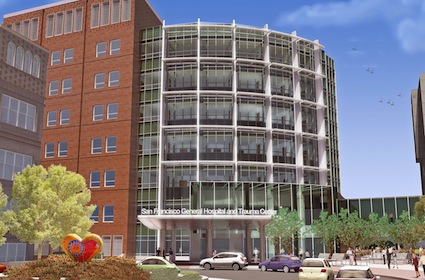$887.4 million Hospital Project Underway in City By the Bay

SAN FRANCISCO — Progress continues on The San Francisco General Hospital Rebuild Project, which broke ground in October 2009 and is scheduled for completion in 2015.
Fong & Chan Architects of San Francisco designed the new 284-bed San Francisco General Hospital & Trauma Center for the City of San Francisco. Webcor Builders (Webcor) is the general contractor, with construction management by Jacobs Engineering Group Inc. The San Francisco Department of Public Works manages the project.
Webcor is coordinating the advertisements for bid packages for the pre-qualified trade subcontractors for the City of San Francisco. It maintains a website at http://sfgh.webcor.com/ with more bidding details, including RFQ and RFP due dates, bidders’ lists and final contract award information related to the rebuild project.
A list of pre-qualified subcontractors for the listed bid packages will be posted and updated as necessary as additional RFQ responses are received for potential second-tier subcontractors, suppliers, vendors, etc. who may be interested in bidding to the pre-qualified subcontractors.
Subcontractors will be allowed to have second-tier and third-tier subcontractors in order to meet the City’s Local Business Enterprise participation goals. These second-tier and third-tier subcontractors do not need to respond to an RFQ but should attend the pre-bid conferences held for each bid package.
The 448,000-square-foot hospital will stand on the property of the existing acute-care General Hospital, which was deemed seismically unsafe and scheduled to close in 2013. The 125-year-old General Hospital currently treats 100,000 patients annually and is the only Level-1 trauma center serving San Francisco and northern San Mateo County.
The new facility will also be a Level-1 trauma center. It features 14 operating rooms, a 40,000 square-foot foot emergency room and a 20,000-square-foot radiology department. Units will provide intensive care, critical care, neonatal intensive care and forensic services. Additional services will include obstetrics, pediatrics, sterile processing, pharmacy, laboratory, pulmonary function, biomedical, morgue and autopsy.
The new hospital will increase general acute bed space by 32 and increase the emergency department from 27 to 60 beds. Operating rooms will increase from 10 to 14.
The nine-story building will be a steel moment frame structure on a mat foundation with base isolators, the most earthquake-resistant design available. The base isolators can slide 30 inches in any direction during an earthquake, which greatly reduces any building movement. The structure will consist of two levels below ground and seven levels above ground, including a mechanical penthouse. The new building will connect to the existing hospital via a pedestrian bridge at the second floor level and a tunnel at the basement level.
The project plans to achieve LEED Gold level certification. The new acute care facility will use 21 percent less energy and 40 percent less potable water than current code requirements. The design includes efficient plumbing fixtures, energy efficient HVAC and lighting systems, the use of natural lighting, use of recycled and sustainable materials, low- or no-VOC flooring, adhesives and finishes, a rooftop garden to reduce storm water runoff and heat island effect, green biodegradable cleaning and other operational products will be used. The construction process will divert recyclable or salvageable waste from being sent to landfills and a base isolated foundation uses 30 percent less steel than traditional foundations.
The new hospital will be built in four phases. Phase I is nearly complete and consists of site utilities relocation and replacement. Phase II consists of service building modifications and equipment additions; work began in October 2010 and scheduled for completion in early 2012. Phase III is underway and consists of excavations, foundations and structure frame. Phase IV consists of the new acute building enclosure and build out.
The $887.4 million in funds to construct the hospital were approved when voters passed Proposition A in November 2008 by an 84 percent margin. The city will finance the rebuild through general obligation bonds.
